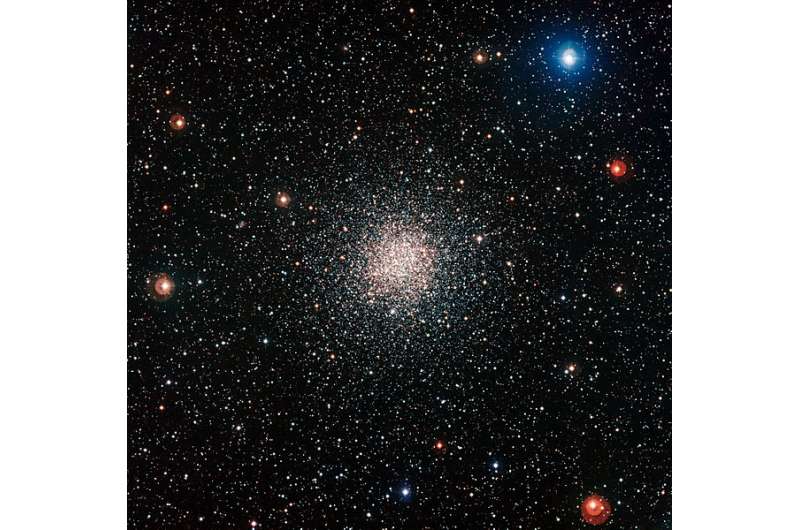This colorful view of the globular star cluster NGC 6362 was captured by the Wide Field Imager attached to the MPG/ESO 2.2-m telescope at ESO’s La Silla Observatory in Chile. Credit: ESO
(Phys.org)—Globular clusters have for a long time been considered as formed of stars with similar initial chemical composition, but recently, increasing evidence has emerged regarding their more complex nature. On Apr. 14, a team of Italian scientists led by Alessio Mucciarelli of the University of Bologna, has published a research paper describing chemical anomalies in the low-mass globular cluster NGC 6362, implying that globular clusters may be not as simple as previously thought. The results are available on the arXiv pre-print server.
NGC 6362 lies some 25,000 light years away in the constellation Ara. It is about 13.5 billion years old and at an estimated mass of approximately 50,000 solar masses, it is the least massive globular cluster with multiple detected photometric stellar populations that have different chemical abundances.
To determine the chemical composition of NGC 6362, the team employed the Fibre Large Array Multi Element Spectrograph (FLAMES) mounted on one of the Unit Telescopes (UT) of the Very Large Telescope (VLT) in Chile. Using FLAMES, the researchers analyzed the spectra of over 200 giant stars and derived chemical abundances of iron and sodium in this cluster. The instrument can obtain, in one shot, high-quality spectra for about 140 stars over a field of view of about 25 arcmin diameter.
"In the case of NGC6362, we have analyzed spectra of more than 200 giant stars around the cluster in order to distinguish star members of the cluster according to their kinematics and chemistry, finally finding 160 member stars. This work is part of a larger project aimed at obtaining a complete description of this globular, in terms of photometric properties, chemical composition, kinematics," Mucciarelli told Phys.org.
The study provided the first chemical characterization of NGC 6362. The authors of the paper determined star-to-star variations in the sodium abundance. According to the research, these variations demonstrate that this relatively small cluster shows the same chemical anomalies observed in more massive clusters.
"Our study about NGC 6362 demonstrates that this cluster is the least massive globular cluster where chemical anomalies in light elements, like sodium and oxygen, are observed," Mucciarelli said.
The research proves an important constraint that stellar clusters down to 50,000 solar masses are able to create sodium-rich stars. It is important to note that open clusters do not show these chemical anomalies and they have masses at least one of order of magnitude smaller than those of the globular clusters. Thus, thanks to the study, NGC 6362 yields an important piece of evidence toward understanding the minimum mass to properly define a globular cluster.
Putting together a number of peculiar properties observed in this cluster, the scientists concluded that these new results comprise a unique case among the galactic globular clusters. They noted that any theory aimed at explaining the formation and evolution of these clusters must account also for the peculiar case of NGC 6362. Moreover, the team emphasized that this collection of stars has still more mysteries waiting to be unveiled.
"This interesting object has still several secrets to reveal. We are planning new observations to study the kinematics of NGC6362 in order to provide a complete characterization of its stellar populations under all the aspects, photometry, chemistry, dynamics," Mucciarelli concluded.
More information: NGC6362: the least massive globular cluster with chemically distinct multiple populations, arXiv:1604.04151 [astro-ph.SR] arxiv.org/abs/1604.04151
Abstract
We present the first measure of Fe and Na abundances in NGC 6362, a low-mass globular cluster where first and second generation stars are fully spatially mixed. A total of 160 member stars (along the red giant branch and the red horizontal branch) have been observed with the multi-object spectrograph FLAMES at the Very Large Telescope. We find that the cluster has an iron abundance of [Fe/H]=—1.09±0.01 dex, without evidence of intrinsic dispersion. On the other hand, the [Na/Fe] distribution turns out to be intrinsically broad and bimodal. The Na-poor and Na-rich stars populate, respectively, the bluest and the reddest red giant branches detected in the color-magnitude diagrams including the U filter. The red giant branch is composed of a mixture of first and second generation stars in a similar proportion, while almost all the red horizontal branch stars belong to the first cluster generation. Until now, NGC 6362 is the least massive globular cluster where both the photometric and spectroscopic signatures of multiple populations have been detected.
© 2016 Phys.org
























